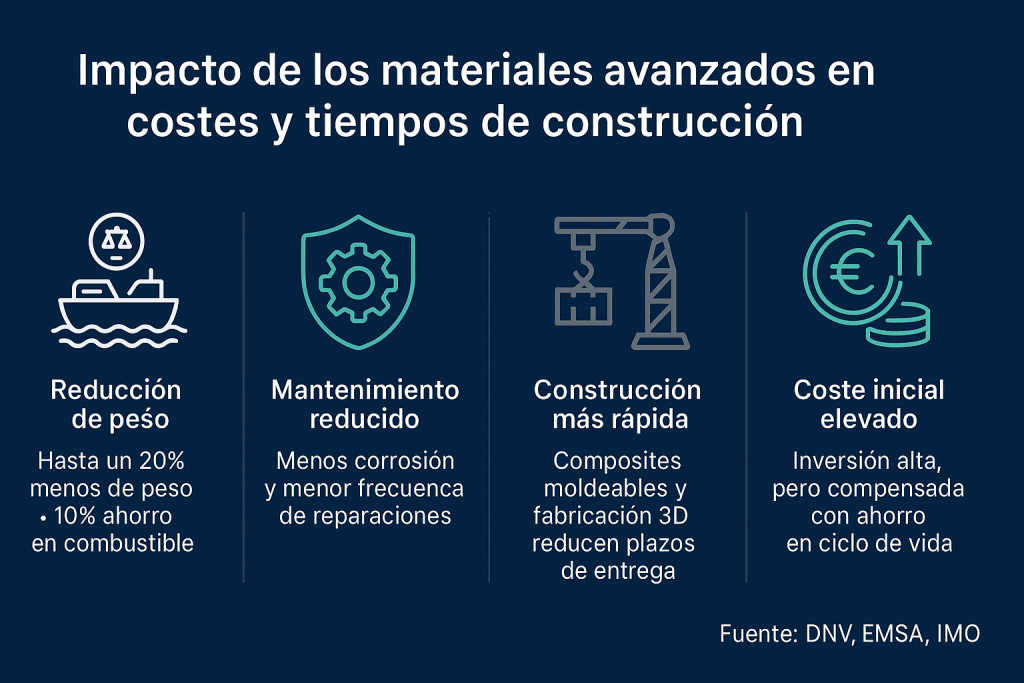
Advanced materials in shipbuilding have become a decisive factor for the future of the maritime industry. Pressure to reduce costs, improve energy efficiency and comply with increasingly stringent environmental regulations is accelerating the incorporation of new composites and metal alloys in ship design and manufacture.
Leading shipyards in Europe and Asia are demonstrating that replacing traditional materials such as steel with lighter composites or high-strength alloys can reduce both structural weight and construction times, generating significant savings throughout the ship’s life cycle.
In this article, we will explore the main emerging materials, their impact on costs and deadlines, and some international success stories.
Somos provisionistas generales de buques
Descubre todos nuestros servicios de suministros navales y marítimos.
1. The evolution of materials in shipbuilding
For much of the 20th century, steel dominated the shipbuilding industry thanks to its strength and availability. However, its heavy weight and high maintenance costs (corrosion, painting, frequent inspections) have prompted the search for alternatives.
Today, the trend focuses on three groups of materials:
- Advanced composites (carbon fibre, fibreglass, hybrid composites).
- Light alloys (naval aluminium, titanium alloys).
- High-strength steel with anti-corrosion treatments.
👉 According to a study by DNV, a 20% reduction in weight can lead to savings of up to 10% in fuel consumption, contributing to the achievement of the IMO 2030 decarbonisation targets.
2. Composites: lightness and durability
a) Fibreglass
- Mainly used in recreational boats and medium-sized ferries.
- Advantages: low cost, corrosion resistance, and ease of moulding.
- Limitation: lower structural strength compared to steel.
b) Carbon fibre
- Increasingly present in high-speed vessels and military ships.
- Advantages: weight reduction of up to 40% compared to steel, high strength and greater speed efficiency.
- Limitation: high cost, which restricts its use to specialised projects.
c) Hybrid composites
- They combine different fibres and resins, balancing strength, durability and cost.
- Applications: decks, superstructures and interior elements in commercial vessels.
👉 Practical example: Austal shipyard in Australia uses aluminium and composites in high-speed catamarans, resulting in lighter vessels with lower fuel consumption.
3. Advanced metal alloys
a) Naval aluminium
- Widely used in fast ferries and military vessels.
- Advantages: corrosion resistance, light weight, and ease of machining.
- Impact: allows for increased payload capacity and improved manoeuvrability.
b) Titanium alloys
- Although more expensive, they offer an excellent strength-to-weight ratio and high corrosion resistance.
- Used in critical components such as propellers, shafts, and systems exposed to salt water.
c) Advanced high-strength steels (AHSS)
- They remain a mainstay in shipbuilding. Their evolution towards lighter versions with improved corrosion resistance has reduced maintenance costs and extended the service life of ships.
👉 Real-life example: the Maersk Triple-E project incorporates high-strength steel in key sections, optimising its structure to carry more cargo with lower fuel consumption.
4. Impact on costs and timescales with advanced materials in shipbuilding
The implementation of advanced materials has a direct impact on the profitability of shipyards and shipping companies:
- Weight reduction: lower fuel consumption and lower CO₂ emissions.
- Reduced maintenance: corrosion-resistant composites and alloys reduce the frequency of repairs.
- Shorter construction time: the ease of moulding composites and the use of digital manufacturing techniques (such as 3D printing of metal sections) shorten delivery times.
- High initial cost: although the price of materials such as titanium and carbon fibre remains high, the savings over the ship’s lifetime offset the investment.
According to the European Maritime Safety Agency (EMSA), the use of advanced materials could reduce the life cycle costs of a commercial vessel by up to 25%.

5. Examples of leading shipyards
- Damen Shipyards (Netherlands): develops hybrid vessels that integrate aluminium and fibreglass into lightweight superstructures.
- Austal (Australia): leader in fast catamarans built from aluminium and composites.
- Naval Group (France): uses composites and titanium in state-of-the-art submarines to reduce noise and improve resistance.
- Mitsubishi Heavy Industries (Japan): researching ultra-lightweight steels and additive manufacturing techniques for the next generation of container ships.
6. Future prospects for advanced materials in shipbuilding
Research into nanocomposites, smart steels and recycled materials will mark the next stage. In the medium term, shipyards will combine advanced materials with digital twins and 3D manufacturing, enabling lighter, more efficient and sustainable ships.
The challenge will be to scale up production of these materials and establish international standards certifying their use in large commercial vessels.
Conclusions
Advanced materials in shipbuilding are now a reality rather than a promise for the future. Although initial costs remain high, the benefits in terms of efficiency, sustainability and competitiveness in the medium and long term are undeniable.
Shipyards that integrate these solutions today will be better positioned to meet the IMO’s environmental targets and respond to the growing demand for more sustainable and cost-effective vessels.



